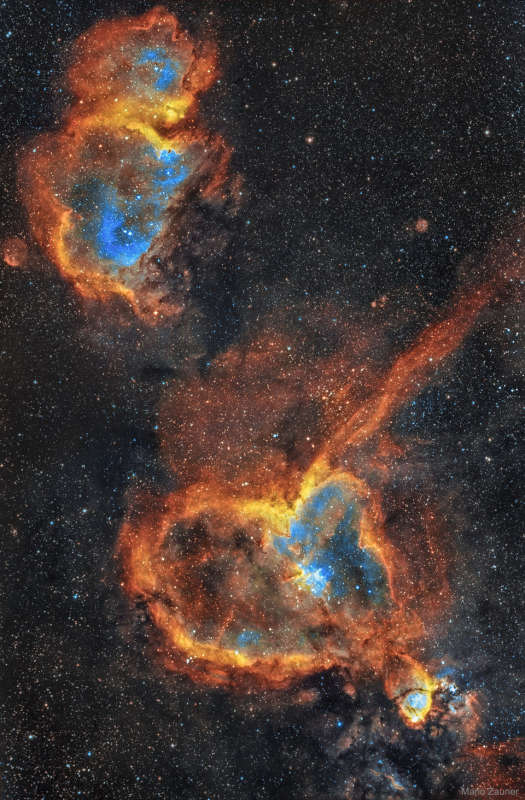
|
Credit & Copyright: Mario Zauner
Explanation:
Is the heart and soul of our Galaxy located in
Cassiopeia?
Possibly not, but that is where two bright
emission nebulas nicknamed
Heart and Soul
can be found.
The Heart Nebula, officially dubbed
IC 1805 and visible in the featured
image on the bottom right, has a shape reminiscent of a classical
heart symbol.
The
Soul Nebula
is officially designated IC 1871 and is visible on the upper left.
Both nebulas shine brightly in the red light of
energized
hydrogen.
Also shown in this three-color montage is light emitted from
sulfur, shown in yellow, and
oxygen, shown in blue.
Several young open clusters of stars are visible near the nebula centers.
Light takes about 6,000 years to reach us from
these nebulas,
which together span roughly 300
light years.
Studies of stars and clusters like those found in the
Heart and
Soul Nebulas
have focused on how massive stars
form and how they
affect their environment.
Follow APOD on:
Instagram,
Facebook,
Reddit, or
Twitter
|
January February March April May June July August September October November December |
| ||||||||||||||||||||||||||||||||||||||||||||||||
NASA Web Site Statements, Warnings, and Disclaimers
NASA Official: Jay Norris. Specific rights apply.
A service of: LHEA at NASA / GSFC
& Michigan Tech. U.
Based on Astronomy Picture
Of the Day
Publications with keywords: Heart Nebula
Publications with words: Heart Nebula
See also:
- APOD: 2024 December 17 Á Near to the Heart Nebula
- APOD: 2024 September 17 Á Melotte 15 in the Heart Nebula
- APOD: 2023 December 13 Á Deep Field: The Heart Nebula
- APOD: 2023 February 14 Á The Heart and Soul Nebulas
- In the Heart of the Heart Nebula
- IC 1805: The Heart Nebula
- The Heart Nebula in Hydrogen, Oxygen, and Sulfur
